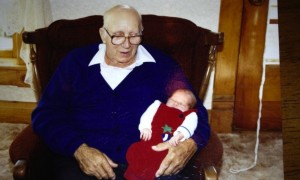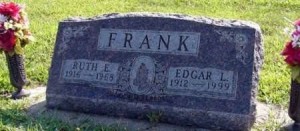
A man walked through the town of Fontanelle, Iowa on a mission, but then he would have to stop because he got lost. He could not remember where he was or what he was suppose to be doing. He walked into the nearest Casey’s General Store seeking to find out where he was at or how to get home.
His youngest daughter, Kaylene Whittlesey, had to explain to him information he couldn’t recall or just forgot about. “I remember having to talk with him about his checking account and how one worked and that you could only write checks for the amount of money in your account.” His life changed as his memories beginning to fade from him as he was diagnosed with Dementia.
Edgar Lawrence Frank was known to many as a man of many smiles, a man willing to talk to anyone, and a man who was willing to help. Towards the end of his life he changed. He was not able to help others as much and had to focus on himself. He was diagnosed with Dementia. He faded from reality and took his memories with him. Leaving the people around him to watch their beloved father, grandfather, brother, and friend disappear.
He was born February 7, 1912 to Jacob George and Florence Bakerink Frank in Adair County, Iowa. His life was a full one. He graduated high school from Fontanelle High School with the class of 1932. From there he started his years as a farmer. He was married to his first wife, Bertha Sears, at the end of summer in 1933. They had one child, Louise before his wife passed away. His second marriage to Ruth Edwards led to four more children, Karen, David, Dennie, and Kaylene.
Even during his farming years, Edgar worked multiple jobs. He was a janitor at a nursing home and a school and he ran heavy construction equipment. He also fought in World War II in the Navy. His obituary states, “Even after, when most people would have retired, Edgar kept active by providing rides to people for doctors appointments, took needed medical information from the nursing home to the hospital so the proper tests could be done and took a great deal of pride in making lawn ornaments.”
Edgar lived his life well up until the moment he begin to lose his memories but he still wore his friendly smile on his face. Even though he could not always remember what he was doing, where he was, or who people were.
Edgar’s memories started to leave him and become unreachable in 1993. He was diagnosed with Dementia, which according to the Alzheimer’s Association is a general term used to describe a fall in mental ability that is serious enough to affect daily life. The most common type of Dementia is Alzheimer’s. The symptoms include memory loss, impaired communication, troubles with visual perception, not able to focus or use reasoning skills. Edgar showed symptoms of memory loss and confusion. He had trouble with remembering the money in his checking account and how to do daily tasks.
Granddaughter of Edgar, Cindy Burg, would visit him in the nursing home. “We would go visit him and he would set and have conversations with people he was in the war with or he had worked with many years ago” says Cindy. He did not even know they were there most of the time visiting him or who they were.
However, in 1993 when Edgar had most of the signs of Alzheimer’s he couldn’t be diagnosed with it until after his death. Back then, doctors had no way to test if it was Alzheimer’s or not. The test would be performed after death on the brain of the deceased to determine the final cause. Edgar did in fact have Alzheimer’s but it was not determined until after he was gone. Him having Alzheimer’s meant that in his brain there were high amounts of proteins outside and inside brain cells. These high amounts of protein make it hard for communication to happen between brain cells which led to the symptoms that Edgar had. According to the Alzheimer’s Association,”Alzheimer’s accounts for 60 to 80 percent of Dementia cases.” Unlike the time when Edgar was going through this, doctors today diagnose Alzheimer’s based on family history, daily functions, lab test results and behavioral changes.
Some patients that are diagnosed with Dementia or Alzheimer’s may either get to the point where they need around the clock care or their family doesn’t have the ability to take care of them any longer and need to go into a home. Edgar voluntarily put himself in a home.
His favorite part of being in a home according to his youngest daughter, Kaylene, was being able to see and visit all the people there and the people that worked there. When he did get worse with memories in the later years the home required him to wear an ankle bracelet to prevent him from wondering off. A few times before the bracelet was in place, he would wonder off and get lost out of the home.
Edgar had Dementia for six years until his death when he was final diagnosed with Alzheimer’s. “It was very hard to see him basically disappear from you. It got to the point he did not even know who you were” Kaylene says.
Edgar Lawrence Frank was put in his final resting spot at the age of 86 on Monday, January 11, 1999. His children, grandchildren, great grandchildren, his sisters, in-laws, nieces, nephews, community members and friends were at a loss that day burring a well loved, smiley man. He received full Military Graveside Rites by the Fontanelle American Legion Carlson Post No. 247.




 Entries (RSS)
Entries (RSS)